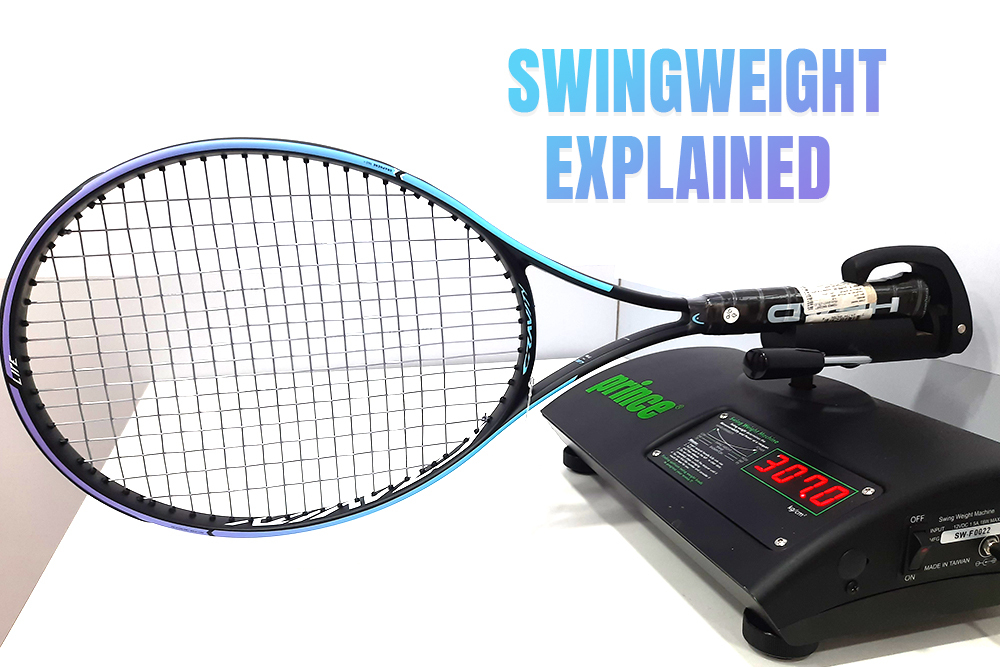A tennis racquet is a highly personal piece of equipment, there is no "perfect racquet" that can be considered ideal for any player, every tennis player from the recreation level to the pro level has a different unique swing path and requires different specifications from their racquet. The swing weight of a tennis racquet is one of the elements that has a big influence on the playing characteristics of a racquet.
What is swingweight?
Swingweight is the resistance of a racquet to being turned about an axis that runs through your hand. The swing weight of a racket is affected by the combination of a racket’s static weight and balance. A racket that is more head heavy will have a higher swing weight than that of a head light racket. Even though these two rackets may weigh the same on the scale, the head-heavy racket will feel heavier during play, hence the higher swing weight. A light swing weight racquet makes it easier for the player to swing the racquet (maneuverable). However, it also makes it easier for the ball to move the racquet, resulting in loss of power and stability.
How do you measure the swing weight of your racquet?
The average strung swing weight is listed in the racquet customization on the tennishub website, under each racquet sold. This is measured by using an RDC machine at our tennishub pro shops.
How do you increase the swing weight?
The swing weight can be increased by adding weight such as lead tape or tungsten tape. Adding weight at the 12 o clock position(the upper hoop) of the racquet has the maximum impact on swing weight which will add the most power, the swing weight increases the most when the weight is placed away from the handle towards the head of the racquet, the closer to the handle the weight is placed, the lower the increase in swing weight would be noticed. Adding weight to the handle near the buttcap does not increase the swing weight, it increases the static weight and makes the racquet more headlight, it is recommended to add weight on the handle near the buttcap to maintain the original balance of the racquet after adding weight to the head of the racquet.
Who should consider increasing their swing weight?
As a player’s level of tennis improves and he/she is facing opponents who hit the ball harder with more power and spin, a higher swing weight would help the racquet maintain stability and power when receiving fast-paced incoming balls and prevents the racquet from moving from the player's hand. Players who have well-developed technique and looking for more stability and plow through should consider increasing their swing weight by adding lead tape or buying a frame with a higher swing weight, it is advisable that they consult their coach or a tennis expert before doing so.
Who should not increase their swing weight?
Players at the recreational level. The biggest trade-off when increasing the swing weight of the racquet is the reduction in maneuverability which could cause the player to take the ball late and, this is a common problem seen at the recreational level where amateurs players try copying the swing weight of pro players by adding huge amounts of lead tape all over the frame, this often does more harm than good to the developing player since they lack the footwork and stroke mechanics that the pro players possess.
This being said, the swing weight numbers of the pro players vary a lot, players like Andy Murray, Djokovic, Berdych and Stan Wawrinka use high swing weights, whereas next-gen players like Nick Kyrgios, Dominic Thiem and Carlos Alcaraz use comparatively much lower swing weights. The lack of stability and power from lower swing weights can be compensated by having a higher racquet head speed, Nick Krygios is a great example of a player who has high racquet head speed(whippy strokes)
Players with loopy strokes will generally prefer a racket with a lower swing weight because maneuverability is so essential for their game. The racket head speed that they rely on for their groundstrokes is hard to come by with rackets that are high in swing weight. On the flip side, players that play flat and through the court generally prefer rackets with high swing weights because it gives them more power as the racket ploughs through the ball at contact.













Comments